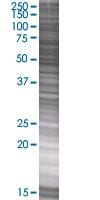FGR overexpression 293T lysate (whole cell) (ab94154)
Overview
-
Product name
FGR overexpression 293T lysate (whole cell) -
General notes
ab94154 is a 293T cell transfected lysate in which Human FGR has been transiently over-expressed using a pCMV-FGR plasmid. The lysate is provided in 1X Sample Buffer. Note: For more details about how the transfected lysate was prepared view preparation notes
-
Tested applications
Suitable for: WBmore details
Properties
-
Mycoplasma free
Yes -
Form
Liquid -
Storage instructions
Shipped on dry ice. Upon delivery aliquot and store at -20ºC. Avoid freeze / thaw cycles. -
Storage buffer
Constituents: 0.01% Bromophenol blue, 2.3% Beta mercaptoethanol, 2% Sodium lauryl sulfate, 0.788% Tris HCl, 10% Glycerol (glycerin, glycerine) -
 Concentration information loading...
Concentration information loading... -
Research areas
-
Background
Function: Non-receptor tyrosine-protein kinase that transmits signals from cell surface receptors devoid of kinase activity and contributes to the regulation of immune responses, including neutrophil, monocyte, macrophage and mast cell functions, cytoskeleton remodeling in response to extracellular stimuli, phagocytosis, cell adhesion and migration. Promotes mast cell degranulation, release of inflammatory cytokines and IgE-mediated anaphylaxis. Acts downstream of receptors that bind the Fc region of immunoglobulins, such as MS4A2/FCER1B, FCGR2A and/or FCGR2B. Acts downstream of ITGB1 and ITGB2, and regulates actin cytoskeleton reorganization, cell spreading and adhesion. Depending on the context, activates or inhibits cellular responses. Functions as negative regulator of ITGB2 signaling, phagocytosis and SYK activity in monocytes. Required for normal ITGB1 and ITGB2 signaling, normal cell spreading and adhesion in neutrophils and macrophages. Functions as positive regulator of cell migration and regulates cytoskeleton reorganization via RAC1 activation. Phosphorylates SYK (in vitro) and promotes SYK-dependent activation of AKT1 and MAP kinase signaling. Phosphorylates PLD2 in antigen-stimulated mast cells, leading to PLD2 activation and the production of the signaling molecules lysophosphatidic acid and diacylglycerol. Promotes activation of PIK3R1. Phosphorylates FASLG, and thereby regulates its ubiquitination and subsequent internalization. Phosphorylates ABL1. Promotes phosphorylation of CBL, CTTN, PIK3R1, PTK2/FAK1, PTK2B/PYK2 and VAV2. Phosphorylates HCLS1 that has already been phosphorylated by SYK, but not unphosphorylated HCLS1. Tissue specificity: Detected in neutrophils, monocytes and natural killer cells (at protein level). Detected in monocytes and large lymphocytes. Disease: Mutations that cause aberrant kinase activation can confer oncogene activity and promote aberrant cell proliferation. Similarity: Belongs to the protein kinase superfamily. Tyr protein kinase family. SRC subfamily. Contains 1 protein kinase domain. Contains 1 SH2 domain. Contains 1 SH3 domain. PTM: Ubiquitinated. Becomes ubiquitinated in response to ITGB2 signaling; this does not lead to degradation. Phosphorylated. Autophosphorylated on tyrosine residues. Becomes phosphorylated in response to FCGR2A and/or FCGR2B engagement, cell adhesion and signaling by ITGB2. Prior phosphorylation at Tyr-523 by SRC inhibits ulterior autophosphorylation at Tyr-412.
Images
-
ab94154 at 15µg/lane on an SDS-PAGE gel.
-
All lanes : Anti-FGR antibody (ab58228) at 1/500 dilution
Lane 1 :FGR overexpression 293T lysate (whole cell) (ab94154)
Lane 2 : 293T Non Transfected Lysate
Lysates/proteins at 25 µg per lane.
Secondary
All lanes : Goat Anti-mouse IgG (H and L) HRP conjugated at 1/2500 dilution







